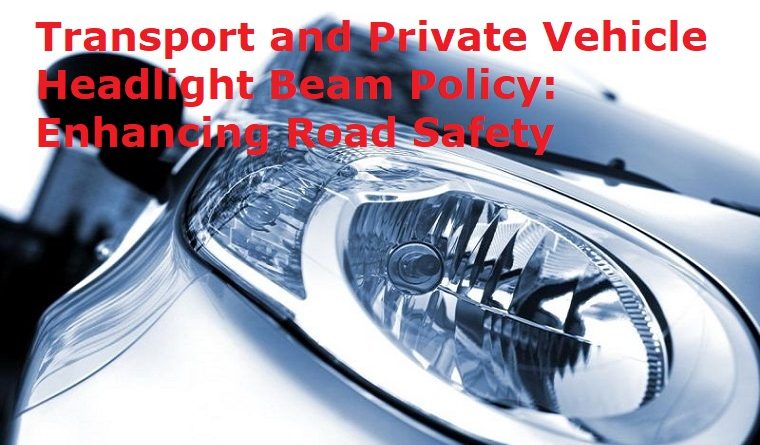Transport and Private Vehicle Headlight Beam Policy: Enhancing Road Safety
Abstract: Road safety is a crucial concern for governments and transportation authorities worldwide. Adequate visibility plays a significant role in preventing accidents, especially during nighttime or adverse weather conditions. Headlights are one of the most important components of a vehicle, illuminating the road ahead and alerting other road users. This article aims to explore the policy guidelines and regulations related to headlight beam usage for both transport and private vehicles, highlighting the importance of ensuring road safety through proper headlight usage.
Introduction
The use of headlights is critical for maintaining road safety and preventing accidents. Properly illuminated roads reduce the risk of collisions and enhance the overall driving experience. This article will discuss the policy guidelines and regulations for headlight beam usage in both transport and private vehicles, emphasizing the need for adherence to these guidelines to promote road safety.
1. Importance of Headlights:
- Enhancing Visibility: Headlights are vital for providing visibility in low light or adverse weather conditions, improving the driver’s ability to see the road, obstacles, and other vehicles.
- Signaling Presence: Headlights serve as a visual signal, alerting other road users to the presence of a vehicle, particularly during low light conditions.
- Communication: Different headlight beam modes, such as high beam and low beam, enable drivers to communicate their intentions and facilitate safe overtaking or passing.
2. Headlight Beam Modes:
- Low Beam: Low beam headlights provide adequate illumination for normal driving conditions without causing excessive glare to oncoming vehicles.
- High Beam: High beam headlights offer enhanced illumination, primarily used for rural or poorly lit areas, but they should be used judiciously to avoid blinding other road users.
3. Policy Guidelines for Transport Vehicles:
- Vehicle Specifications: Transport vehicles, including buses and trucks, should be equipped with headlights that meet specific brightness and beam angle requirements to ensure optimal visibility without causing discomfort to other drivers.
- Headlight Alignment: Regular maintenance and proper alignment of headlights are necessary to ensure the correct distribution of light on the road and avoid glare or insufficient illumination.
- High Beam Usage: Transport vehicles must follow strict regulations regarding high beam usage, especially in urban areas or areas with heavy traffic. Proper signage and driver education are crucial in promoting responsible high-beam usage.
4. Policy Guidelines for Private Vehicles:
- Headlight Brightness: Private vehicles should have headlights with appropriate brightness levels to ensure visibility without causing excessive glare or discomfort to other road users.
- High Beam Usage: Private vehicle owners must adhere to regulations regarding using high beams. Switching to low beams in the presence of oncoming vehicles or following other vehicles is necessary to prevent blinding other drivers.
- Retrofitting and Aftermarket Modifications: Regulations should address the use of aftermarket modifications, such as high-intensity discharge (HID) or light-emitting diode (LED) headlights, to ensure they meet required standards and do not create a safety hazard.
5. Enforcement and Penalties:
- Regular Inspections: Authorities should conduct periodic inspections of vehicles to check headlight functionality, alignment, and compliance with regulations.
- Driver Education: Educating drivers about proper headlight usage and the potential risks of misusing high beams is essential for promoting road safety.
- Penalties: Strict penalties should be enforced for drivers who violate headlight beam regulations, discouraging non-compliance and promoting responsible usage.
Adequate visibility provided by properly functioning headlights is crucial for preventing accidents and minimizing risks. Governments and transportation authorities should continue emphasizing the importance of adhering to headlight beam policies and regulations. This can be achieved through regular inspections, driver education programs, and strict penalties for non-compliance.
Efforts should be made to educate drivers about the significance of proper headlight usage, including the appropriate use of high beams in specific situations. Drivers should be aware of the potential risks of misusing high beams, such as blinding other drivers and compromising road safety.
Moreover, both transport and private vehicle owners should be encouraged to maintain their headlights in optimal condition. Regular maintenance, including alignment checks and bulb replacements when necessary, ensures that headlights perform their intended function effectively. Authorities can establish inspection centers or programs to assist vehicle owners in maintaining their headlights and complying with regulations.
To further enhance road safety, collaboration between transportation authorities, vehicle manufacturers, and lighting technology experts is crucial. Technological advancements, such as adaptive headlights that adjust brightness and beam patterns based on road conditions, can significantly contribute to improving visibility and reducing accidents.
It is also essential to address the issue of retrofitting and aftermarket modifications. Regulations should clearly define the standards and specifications for aftermarket headlights, such as HID or LED lights, to prevent the installation of substandard or improperly aligned lighting systems that may pose safety hazards.
In conclusion, implementing and enforcing headlight beam policies and regulations for both transport and private vehicles play a vital role in enhancing road safety. Proper headlight usage, including the responsible use of high beams, ensures optimal visibility while minimizing glare for other road users. Governments, transportation authorities, and drivers must collaborate to raise awareness, educate, and enforce compliance with headlight beam policies. By prioritizing road safety and ensuring adequate visibility on the roads, we can work towards reducing accidents and creating safer transportation environments for all.



very interesting article I really like it, thanks for sharing
Good article. I definitely appreciate this website. Thanks!
Good post. I learn something new and challenging on sites I stumbleupon everyday. It will always be interesting to read content from other authors and practice a little something from other sites.